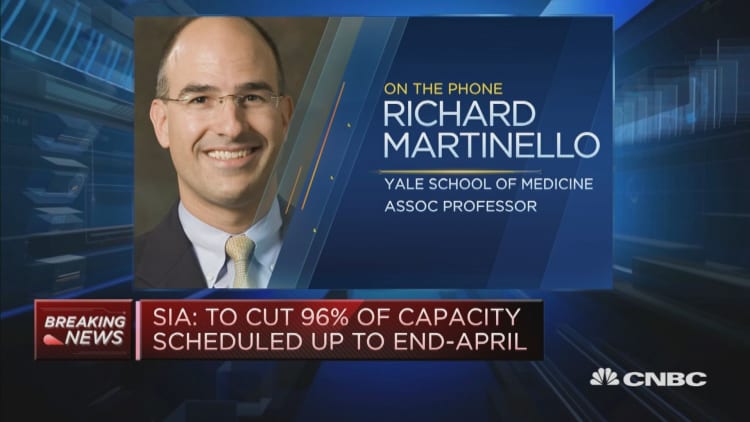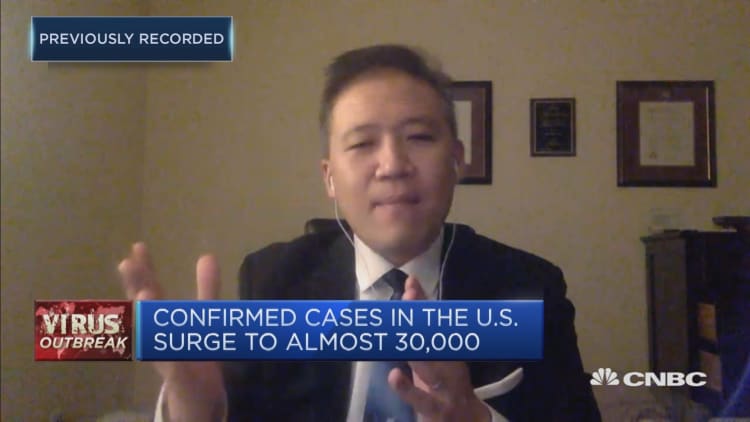
The United States needs more personal protective equipment for its frontline health-care workers as it looks to slow down the rate of new coronavirus infections.
Lack of personal protective equipment such as respirators, eye protection, gloves, and gowns for medical staff is a source of "major frustration," according to Richard Martinello, associate professor of medicine (infectious diseases) and of pediatrics at the Yale School of Medicine.
"These are really critical items that are necessary for our staff, including our physicians, our nurses and so many others to safely do their jobs," he told CNBC's "Squawk Box" on Monday. "Unfortunately, we are finding ourselves in very short supply for these items."
COVID-19 is a respiratory disease caused by a new coronavirus that was first detected in China's Hubei province in late December. The virus has infected more than 300,000 people and killed over 12,000, with the World Health Organization labeling it a global pandemic. More than 35,200 people have been infected in the United States, according to data compiled by Johns Hopkins University; New York state alone has reported more cases than South Korea.
Officials in the U.S. and other countries are employing stringent measures in an attempt to keep the daily number of new reported cases at a level manageable for health-care systems, a concept known as "flattening the curve." Those actions include shutting down public places and large gatherings or banning non-resident visitors from entering.
It would take a minimum of seven days or more for containment and mitigation efforts to start having any effect, according to Eric Feigl-Ding, an epidemiologist and health economist at the Harvard T.H. Chan School of Public Health.
"We have to get to the testing frontier for the new cases to stop emerging, and that will take at least a week," he told CNBC's "Street Signs." He added that any measurable slowdown of the infection in the U.S. will likely take around three to four weeks.
Feigl-Ding said a new U.S. Food and Drug Administration-approved testing kit to detect COVID-19 could be a potential "game-changer" as it drastically cuts down the time taken to determine if a person is infected, provided that the results are accurate. The test is said to take about 45 minutes to complete and can be administered in hospitals.
US following in Italy's path
Both Martinello and Feigl-Ding said that the U.S. is likely following a similar trajectory as Italy —the worst-hit country outside China, where the health care system is being stretched to its limits.
"It seems like we're following the same trajectory that was seen in areas such as Italy," Martinello said.
"We're anticipating that over the next number of weeks, we're going to see a substantial increase in the number of persons infected with (COVID-19) and substantial increase in those who require hospital care. So, I think we're anticipating really in about three to four weeks, we'll be seeing our peak here in the U.S.," he added.

Last week, President Donald Trump invoked a rule that gives him the authority to compel U.S. companies to suspend normal production schedules and begin manufacturing particular materials needed in a time of crisis; in this case, medical supplies that have become scarce.
"While I'm pleased to see that the industrial capabilities are going to be turned toward these needs, I'm afraid it's going to really take some time for production to begin and for sufficient supplies to start to roll out," Martinello said.
New reported cases have gone down in some countries, most notably in South Korea; just a few weeks ago, the rate of infection was growing exponentially. Even China in recent days said Hubei province and its main city, Wuhan, had no new reported cases of the disease.
Feigl-Ding said that it is not possible to compare the situation there to Wuhan.
"We can't divert one quarter of all doctors and nurses from other parts of the country to come to one epicenter like China did," he said. "We're in it for at least two months or more. And, maybe, the vaccine will arrive earlier than 12 months if we get really successful trials."
WHO officials have said at least 20 coronavirus vaccines are in development as the world races for a cure.
He added that if there isn't enough personal protective equipment to keep doctors safe, then the capacity for hospitals to deliver care to patients will drop.
"If we keep dropping the hospital capacity, you're never going to flatten the curve enough," Feigl-Ding said.
Clarification: This article has been updated to clarify that Eric Feigl-Ding says it would take at least a week for containment and mitigation efforts to start having any effect in the United States.


